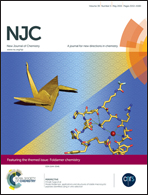Sulfonated Schiff base dinuclear and polymeric copper(ii) complexes: crystal structures, magnetic properties and catalytic application in Henry reaction†
Abstract
The syntheses and X-ray diffraction structures of water soluble copper(II) compounds containing the Schiff base ligand 2-(2-pyridylmethyleneamino)benzenesulfonate (L−), viz. the dinuclear bis-μ1,1-azido [CuL(μ1,1-N3)]2 (1) and bis-μ1,3-thiocyanato [CuL(μ1,3-NCS)]2·2H2O (2) complexes and the μ1,5-dicyanamide coordination polymer [CuL(μ1,5-NCNCN)]n·nH2O (3), are reported. The one dimensional chain in 3 propagated through μ1,5-dicyanamide bridges is stabilized by a new type of sixteen membered metallacycle supported by copper and H-bonds. Variable-temperature (2–300 K) magnetic studies indicate that there is a weak ferromagnetic exchange coupling in 1, while 2 and 3 have weak antiferromagnetic exchange interactions. They catalyze the diastereoselective nitroaldol (Henry) reaction of different aldehydes with nitroethane in aqueous medium. Water was the solvent used for both the syntheses and catalytic studies.



 Please wait while we load your content...
Please wait while we load your content...